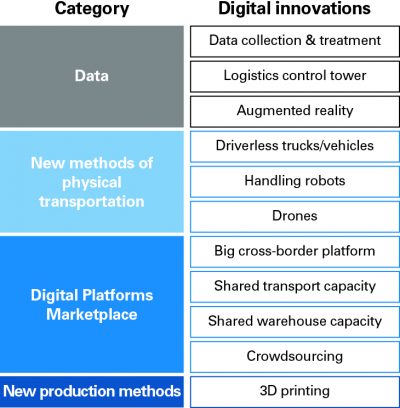 Historically, traditional logistics players such as DHL, Kuehne + Nagel, DB Schenker, UPS and Nippon Express have operated in a stable world, where efficiency, standardisation and low cost have been the keys to success. Digitalisation, however, has begun to change this focus, transforming the market. New, digital-native entrants are better able to adapt to emerging imperatives such as agility, customer-centricity and the need to constantly innovate.
Historically, traditional logistics players such as DHL, Kuehne + Nagel, DB Schenker, UPS and Nippon Express have operated in a stable world, where efficiency, standardisation and low cost have been the keys to success. Digitalisation, however, has begun to change this focus, transforming the market. New, digital-native entrants are better able to adapt to emerging imperatives such as agility, customer-centricity and the need to constantly innovate.
Traditional players know they have to adapt but can find it difficult to change directions efficiently and with agility. They can choose from a wide range of technological innovations but may struggle to identify which ones to adopt and which parts of their business models they should focus on if they are to transform, stay in the game and remain competitive.
Logistics 4.0 paradigmDigital innovation enables logistics players to drive efficiency and lower costs, as well as pursue new business opportunities. This transformation is leading to a new paradigm called Logistics 4.0, which is based on four key trends:
Data automation and transparency – Data has always been at the heart of logistics and new advances in data collection and analysis allow companies to better meet their goals strategically, such as by optimising their route networks; tactically, such as by optimising the number of trucks and drivers required each day; and also operationally, such as by tracking deliveries in real time.
New methods of transport – Driverless vehicles, handling robots and drones are already in operation and showing financial benefits to the companies that have adopted them. Introducing these innovations successfully raises new questions around areas such as employment, control and liability.
Digital platforms – By allowing the sharing of capital expenses around areas such as warehouses and fleets, digital platforms represent the biggest disruption to the sector, because they enable new, capex-free actors to enter the ecosystem and open up new business models. The platform model leads to a race for size, often resulting in a 'winner-takes-all' model, or at least a very concentrated market. In addition, crowdsourcing-based business models are still emerging. However, first initiatives open the sector up to new, disruptive models.
New production methods – Techniques such as additive manufacturing (3D printing) have the potential to change traditional logistics, enabling new, decentralised business models. This creates the opportunity for contract logistics providers to integrate 3D printing services into their offerings, providing last-mile customisation.
Currently the logistics landscape is defined by antiquated customer interfaces, a lack of pricing transparency and asset utilisation inefficiencies, with empty ships, trucks and containers. This means the industry is vulnerable to the disruptive impact of digitalisation.
Selecting top prioritiesUnderstanding the right approach to take begins with the trends that could impact on your business most. From this, logistics players should create shortlists of topics to address.
Among the key points to bear in mind are that processes at all levels of the supply chain will be impacted by Logistics 4.0 and LLPs will face some difficult investment choices, often involving significant capital expenditure and high levels of risk. Supply chain architecture will be transformed by digitalisation, meanwhile, so logistics players need to understand when the move to digitalisation is likely to occur and evaluate whether they should drive early change by partnering with different players in the logistics network.
The competitive landscape is already changing. Although legacy players have a part to play, major disruption is expected to come from new entrants, free of the need to run their existing, low-margin core businesses. Traditional players must therefore step back and rethink their positions in the supply chain.
Digitalisation will enable companies to enrich their offerings and improve customer experience, however. Traditional logistics players need to understand which topics to prioiritise, depending on their businesses, and work out how their customer experience can be improved.
Another issue is that market needs will change with digitalisation. Existing players need to understand how to anticipate these trends and follow them, and be prepared for disruption.
Picking the right action modeThere are various ways to go about such changes. They include:
Disruption project powered by group function – To tackle major disruption, if the company has the relevant skills in-house, an ad hoc project team should be created, with governance at the group level. The common pitfalls of implementing this mode revolve around organisation, such as how to focus senior resources on temporary projects full-time.
Entrepreneurial project in branches – In the case of limited disruption, when the company has the relevant skills in-house, a specific project should be created at the branch level. Companies should consider whether the project results can be applied to other branches, bearing the 'not-invented/initiated-here' syndrome in mind.
Open lab – If disruption is expected to be major but the company does not have the relevant skills in-house, it should set up an initiative such as an open laboratory. However, issues around intellectual property management are frequent and must be planned for.
Open project – If disruption is expected to be small and the company does not have the relevant skills in-house, an open project initiative may work best. Similar to the open lab approach, it is much less resource-intensive but more difficult to manage, as many players are involved. Intellectual property becomes a major topic in such instances.
Although the logistics industry is relatively late in stepping into digital transformation, Logistics 4.0 is on its way. Radical innovations, new entrants and external factors are about to disrupt every segment of the logistics chain.
Traditional logistics players need to investigate the risks and opportunities and find the right balance between a top-down, strategic vision and a bottom-up sprint. And whatever their implementation choices, they will also have to pay close attention to their execution.
Vincent Bamberger is managing partner at management consultancy Arthur D. Little's Paris office. Florent Nansé, Bernd Schreiber and Michael Zintel also contributed to this report.
























